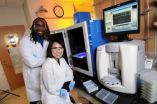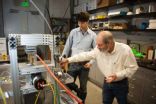(Press-News.org) Physician-researchers at Indiana University School of Medicine have reported the first effective therapy for a class of previously untreatable and potentially life-threatening tumors often found in children.
Announcing their findings in the online first edition of Lancet Oncology, the researchers said the drug imatinib mesylate, marketed as Gleevec as a treatment for chronic myeloid leukemia, provided relief to a significant number of patients with plexiform neurofibromas, tumors caused by neurofibromatosis type 1, or NF1.
"Although this was a small study, the results were significant, particularly given that such patients have had few treatment options for what can be a very debilitating disease," said first author Kent Robertson, M.D., Ph.D., associate professor of pediatrics. "We believe these findings warrant larger trials of both imatinib mesylate as well as other similar compounds that would appear promising in laboratory tests."
Affecting about 1 in every 3,000 children born, NF1 is the most common neurological disorder caused by mutations in a single gene. Including a much rarer related type, NF2, neurofibromatosis is a genetic disorder that is more prevalent than cystic fibrosis, Duchenne muscular dystrophy and Huntington's disease combined, according to the Children's Tumor Foundation.
The mutation produces a variety of symptoms, from mild to severe. Patients can develop café au lait spots and disfiguring tumors on or just under the skin. Internally, tumors can develop along nerve tissue and cause problems if they begin to press against vital organs or the windpipe. Some patients suffer from chronic pain.
The tumors have been nearly impossible to treat effectively. Because they are relatively slow growing, they are not affected by radiation treatments or cancer chemotherapy drugs. They also are often not good candidates for surgery because they are dangerously close to vital organs.
In the study reported in Lancet Oncology, of 23 patients who received the drug for at least six months, six experienced a 20 percent or more decrease in the volume of one or more plexiform neurofibromas, and 30 percent of patients had improvements in symptoms.
Primary investigator D. Wade Clapp, M.D., Richard L. Schreiner Professor and chairman of the Department of Pediatrics, noted that even relatively small reductions in tumor size can result in significant relief of symptoms for patients, such as improved breathing and restoration of bladder control.
In earlier laboratory research, the researchers determined that Gleevec was effective in tissue culture and mouse models of NF1 tumors after discovering that a cellular signaling mechanism that Gleevec targets in chronic myeloid leukemia also played an important role in development of NF1 tumors. Reporting that finding in the journal Cell in 2008, the research team also reported that in a compassionate use protocol, they had treated a 3-year-old girl with a life-threatening tumor compressing her airway. The girl's tumor shrank by half within three months of treatment.
Although Gleevec has been widely used as a treatment for chronic myeloid leukemia and has been prescribed in some cases for long periods without serious side effects, 13 of the initial 36 patients enrolled in the IU study dropped out before their results could be analyzed at six months of treatment. Nine of the 13 left due to problems taking the drug or side effects. The authors noted that they used the previously established maximum tolerated dose for Gleevec for this study to ensure that any drug activity against any NF1 tumors would be observed. This approach was taken among patients who had been living with slow-growing tumors for long periods of time and therefore were less likely to accept drug side effects than patients with malignant tumors, the authors suggested. Dosages have been modified in subsequent studies.
INFORMATION:
Additional authors included, from the IU School of Medicine, Grzegorz Nalepa, M.D., Feng-Chun Yang, M.D., Chang Y. Ho, M.D., Gary D. Hutchins, Ph.D., James M. Croop, M.D., Terry A. Vik, M.D., Scott C. Denne, M.D., Laurence E. Walsh, M.D., Kamnesh R. Pradhan, M.D., Mary K. Edwards-Brown, M.D., Mervyn D. Cohen, M.D., James W. Fletcher, M.D., Jeffrey B. Travers, M.D., Karl W. Staser, Ph.D., Melissa W. Lee, B.S., Marcie R. Sherman, B.S., Lucy C. Miller, RN, and David A. Ingram, M.D.; Daniel C. Bowers, M.D., and Luis F. Parada, Ph.D., of the University of Texas Southwestern Medical School; Cynthia M. Hingtgen, M.D., of Michigan State University; Menggang Yu, Ph.D., of the University of Wisconsin; and Cynthia J. Davis, RN, of the Franciscan St. Francis Cancer Center, Indianapolis.
Drs. Clapp, Robertson, Yang, Travers, and Ingram are members of the Indiana University Melvin and Bren Simon Cancer Center and the Herman B Wells Center for Pediatric Research Drs. Hutchins, Croop, Vik, Pradhan and Fletcher are members of the IU Simon Cancer Center. Drs. Denne and Nalepa are members of the Wells Center for Pediatric Research.
Sources of funding for the research included the IU Simon Cancer Center, the Wells Center for Pediatric Research, a KL2 TR000163 Clinical and Translational Sciences Award from the National Institutes of Health, and NIH grants P50 NS 052606 and RO1CA74177. Novartis Pharmaceuticals provided the imatinib mesylate study drug.
IU researchers report first effective treatment of tumors arising from common genetic disease NF1
2012-11-01
ELSE PRESS RELEASES FROM THIS DATE:
Super-rare, super-luminous supernovae are likely explosion of universe's earliest stars
2012-11-01
The most-distant, super-luminous supernovae found to date have been observed by an international team, including Raymond Carlberg of the University of Toronto's Department of Astronomy & Astrophysics. The stellar explosions would have occurred at a time when the universe was much younger and probably soon after the Big Bang.
"The objects are both unusually bright and unusually slow to fade. These are properties that are consistent with what is known as pair-instability supernova, a rare mechanism for explosion which is expected to happen for high-mass stars with almost ...
Stem cells could heal equine tendon injuries
2012-11-01
Tendon injuries affect athletic horses at all levels. Researchers from the University of Connecticut are studying the use of stem cells in treating equine tendon injuries. Their findings were published Oct. 16 in the Journal of Animal Science Papers in Press.
Tendon injuries in horses tend to worsen over time as damage to the tendon creates lesions. Currently, horse owners treat tendon injuries by resting the horse and then carefully exercising the horse to control the growth of scar tissue in the tendon. Unfortunately, this treatment does not always work.
"These injuries ...
LSUHSC research identifies new therapeutic target for Alzheimer's disease
2012-11-01
New Orleans, LA – Research led by Chu Chen, PhD, Associate Professor of Neuroscience at LSU Health Sciences Center New Orleans, has identified an enzyme called Monoacylglycerol lipase (MAGL) as a new therapeutic target to treat or prevent Alzheimer's disease. The study was published online November 1, 2012 in the Online Now section of the journal Cell Reports.
The research team found that inactivation of MAGL, best known for its role in degrading a cannabinoid produced in the brain, reduced the production and accumulation of beta amyloid plaques, a pathological hallmark ...
Rethinking reading
2012-11-01
Many educators have long believed that when words differ on only one sound, early readers can learn the rules of phonics by focusing on what is different between the words. This is thought to be a critical gateway to reading words and sentences.
But scientists at the University of Iowa are turning that thinking on its head. A recent study published in "Developmental Psychology" shows certain kinds of variation in words may help early readers learn better. When children see the same phonics regularities, embedded in words with more variation, they may learn these crucial ...
Laser-light testing of breast tumor fiber patterns helps show whose cancer is spreading
2012-11-01
Using advanced microscopes equipped with tissue-penetrating laser light, cancer imaging experts at Johns Hopkins have developed a promising, new way to accurately analyze the distinctive patterns of ultra-thin collagen fibers in breast tumor tissue samples and to help tell if the cancer has spread.
The Johns Hopkins researchers say their crisscrossing optical images, made by shining a laser back and forth across a biopsied tissue sample a few millionths of a meter thick, can potentially be used with other tests to more accurately determine the need for lymph node biopsy ...
George Mason University researchers target breast cancer in 3 trials
2012-11-01
Fairfax, Va. -- A malarial drug is showing promise in stopping breast cancer before it starts, Mason researchers are discovering during a clinical trial.
"The bold long-term goal is a short-term oral treatment that prevents breast cancer by killing the precursor cells that initiate breast cancer," says Lance Liotta, co-director of Mason's Center for Applied Proteomics and Molecular Medicine (CAPMM). "And it's looking hopeful."
The PINC trial (Preventing Invasive Neoplasia with Chloroquine) targets ductal carcinoma in situ, or DCIS, the most common type of pre-invasive ...
Researchers use blood testing to predict level of enzymes that facilitate disease progression
2012-11-01
Predicting how atherosclerosis, osteoporosis or cancer will progress or respond to drugs in individual patients is difficult. In a new study, researchers took another step toward that goal by developing a technique able to predict from a blood sample the amount of cathepsins—protein-degrading enzymes known to accelerate these diseases—a specific person would produce.
This patient-specific information may be helpful in developing personalized approaches to treat these tissue-destructive diseases.
"We measured significant variability in the amount of cathepsins produced ...
Mice with 'humanized' livers improve early drug testing, Stanford scientists show
2012-11-01
STANFORD, Calif. — Stanford University School of Medicine scientists have used bioengineered mice with livers composed largely of human cells to characterize a drug about to enter early-stage clinical development for combating hepatitis C.
Tests using the new mouse model accurately predicted significant aspects of the drug's behavior in humans — including its interaction with another drug and the profile of its major breakdown products in the body (called metabolites) — far more accurately than would have been achieved using current methods.
The study will be published ...
Regional analysis masks substantial local variation in health care spending
2012-11-01
PITTSBURGH, Oct. 31, 2012 – Reforming Medicare payments based on large geographic regions may be too bluntly targeted to promote the best use of health care resources, a new analysis from the University of Pittsburgh Graduate School of Public Health suggests. The analysis will be published in the Nov. 1 issue of the New England Journal of Medicine.
"Much policy attention has been drawn to the large geographic variation in health care spending across regions, and for good reason – because regional variation points to inefficient use of resources," said lead author Yuting ...
Tabletop fault model reveals why some quakes result in faster shaking
2012-11-01
Berkeley — The more time it takes for an earthquake fault to heal, the faster the shake it will produce when it finally ruptures, according to a new study by engineers at the University of California, Berkeley, who conducted their work using a tabletop model of a quake fault.
"The high frequency waves of an earthquake — the kind that produces the rapid jolts — are not well understood because they are more difficult to measure and more difficult to model," said study lead author Gregory McLaskey, a former UC Berkeley Ph.D. student in civil and environmental engineering. ...



